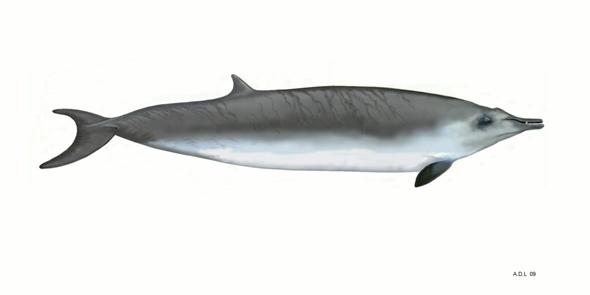Species Index


Key Facts
Length: Up to 5.5 metresRange: North Atlantic Ocean
Threats: Marine litter, acoustic disturbance, pollution
Diet: Mainly squid and some fish
Sowerby's Beaked Whale
Latin: Mesoplodon bidens
Physical Description
The Sowerby’s beaked whale has a prominent beak and, in adult males, one tooth on each side protrudes from the closed mouth; these teeth are about 10 cm long and point backwards. The melon is sloping, but not bulbous, and there is a small, curved dorsal fin. There is a slight depression in the body beneath each pectoral fin, known as the ‘flipper pocket’. Colouration is a dark grey upper surface with a paler coloured belly. Older animals, particularly adult males, may have white coloured scratches (tooth rakes) and circular scars (caused by parasites). Adults can measure up to 5.5 metres in length.
Habitat and Distribution
Sowerby’s beaked whales are found in the north Atlantic Ocean. Their range extends along the east coast of North America and Canada, offshore in open waters, and from northern Africa to the Scandinavian coast. They prefer deep waters and along continental shelf edges. Sightings in Hebridean waters are rare and records include stranded animals.
Behaviour
Sowerby’s beaked whales are known to strand, and occasionally strand in groups. They are elusive animals that do not generally approach boats.
Food and Foraging
Sowerby’s beaked whales feed predominantly on squid but are known to take fish, including cod. Other than the pair of teeth in adult males, beaked whales are toothless and are thought to use suction to catch their prey.
Status and Conservation
There are no population estimates for Sowerby’s beaked whales. The main threats include the accumulation of toxic pollutants in whale tissue and organs, entanglement in fishing nets and marine litter, and noise disturbance. They may also swallow plastic bags mistaken for prey, which can accumulate in the stomach of the animal causing starvation and eventual death. Sowerby’s beaked whales are protected under UK and EU law, principally under Schedule 5 of the Wildlife and Countryside Act 1981, the Nature Conservation (Scotland) Act 2004 and by the 1992 EU Habitats and Species Directive.





